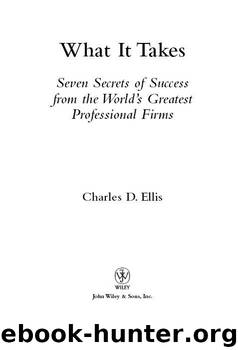What It Takes: Seven Secrets of Success from the World's Greatest Professional Firms by Charles D. Ellis

Author:Charles D. Ellis [Ellis, Charles D.]
Language: eng
Format: mobi
Publisher: Wiley
Published: 2013-01-28T14:00:00+00:00
Long before Goldman Sachs forced its way into the top rank in international investment banking, Mayo Clinic was quietly innovating its way to the top rank in health care. Dr. Charlie Mayo declared that the day he hired Henry Plummer in 1901 to take over the clinical laboratories and x-ray diagnosis was “the best day’s work I’d ever done for the Clinic.” Believing the clinic should make its records accurate, complete, and readily accessible to all its physicians, Plummer won approval in 1907 to develop a revolutionary new system of record keeping. Traditionally, doctors kept their records separately and chronologically in large ledgers. Over a year of study—particularly including visits to organizations outside medicine—Dr. Plummer developed the clinic’s famous dossier system, in which each patient was assigned a number that was put on an envelope. Inside the envelope went all information about that patient: diagnostic history, surgical and hospital records, and all lab data in standardized formats. Each time the patient returned to Mayo Clinic, all new information went into the same file. The files were cross-indexed by disease, surgical technique, pathology findings, or surgical results. Plummer’s record-keeping system contributed decisively to Mayo Clinic’s development as an integrated, multispecialty group practice and to bringing all the specialists consulting on a particular case onto a virtual team.*
Today the descendant of Plummer’s original system is a core competitive advantage for Mayo. Before a patient arrives, that patient’s coordinating physician or “champion” can, through a central resource, pre-schedule all the requisite tests and specialists likely to be participating in the diagnosis. If other specialists are needed, they can be added during the patient’s first visit. Mayo calls this patient-centered, all-in-one-place, all-at-one-time convenience “single-destination care.” To accumulate the same tests and specialist visits elsewhere could take the peripatetic patient a month or longer.
Group practice was a radical approach to medicine 100 years ago. The American Medical Association declared it “soviet medicine.” While many academic medical centers now describe themselves as group practices, they tend to divide into medical schools, hospitals, and medical staffs with separate and often financially competing subgroups or departments whose priorities conflict. At Mayo, “all is one,” in the words of Stephen Swensen, whose title is director of value. “We are all aligned toward Mayo Clinic, not toward separate departments. If cardiology has any money left over, that money is Mayo Clinic money, not cardiology money. There is no personal financial interest in a patient’s gall bladder or an extra imaging exam. And I believe this is a very, very important differentiator.” Philosophically, this practice traces back to the Mayo brothers’ joint checking account.
Health care is a team sport. Since 1948, a group of systems engineering specialists in the system and procedures group, a unique feature of Mayo Clinic, has been finding ways to increase the efficiency and effectiveness of health-care delivery. Mayo has established a well-funded Center for Innovation—a skunk-works that takes on projects of all sizes in a sustained commitment to continuous improvement. In a typical project, a department found that its surgeons had half a dozen different ways of performing a particular procedure.
Download
This site does not store any files on its server. We only index and link to content provided by other sites. Please contact the content providers to delete copyright contents if any and email us, we'll remove relevant links or contents immediately.
Hit Refresh by Satya Nadella(8854)
The Compound Effect by Darren Hardy(8508)
Change Your Questions, Change Your Life by Marilee Adams(7371)
Nudge - Improving Decisions about Health, Wealth, and Happiness by Thaler Sunstein(7242)
The Black Swan by Nassim Nicholas Taleb(6762)
Deep Work by Cal Newport(6563)
Daring Greatly by Brene Brown(6222)
Rich Dad Poor Dad by Robert T. Kiyosaki(6174)
Principles: Life and Work by Ray Dalio(5957)
Man-made Catastrophes and Risk Information Concealment by Dmitry Chernov & Didier Sornette(5646)
Playing to Win_ How Strategy Really Works by A.G. Lafley & Roger L. Martin(5493)
Digital Minimalism by Cal Newport;(5389)
Big Magic: Creative Living Beyond Fear by Elizabeth Gilbert(5351)
The Myth of the Strong Leader by Archie Brown(5237)
The Slight Edge by Jeff Olson(5199)
Discipline Equals Freedom by Jocko Willink(5156)
The Motivation Myth by Jeff Haden(5001)
Stone's Rules by Roger Stone(4854)
The Laws of Human Nature by Robert Greene(4770)
